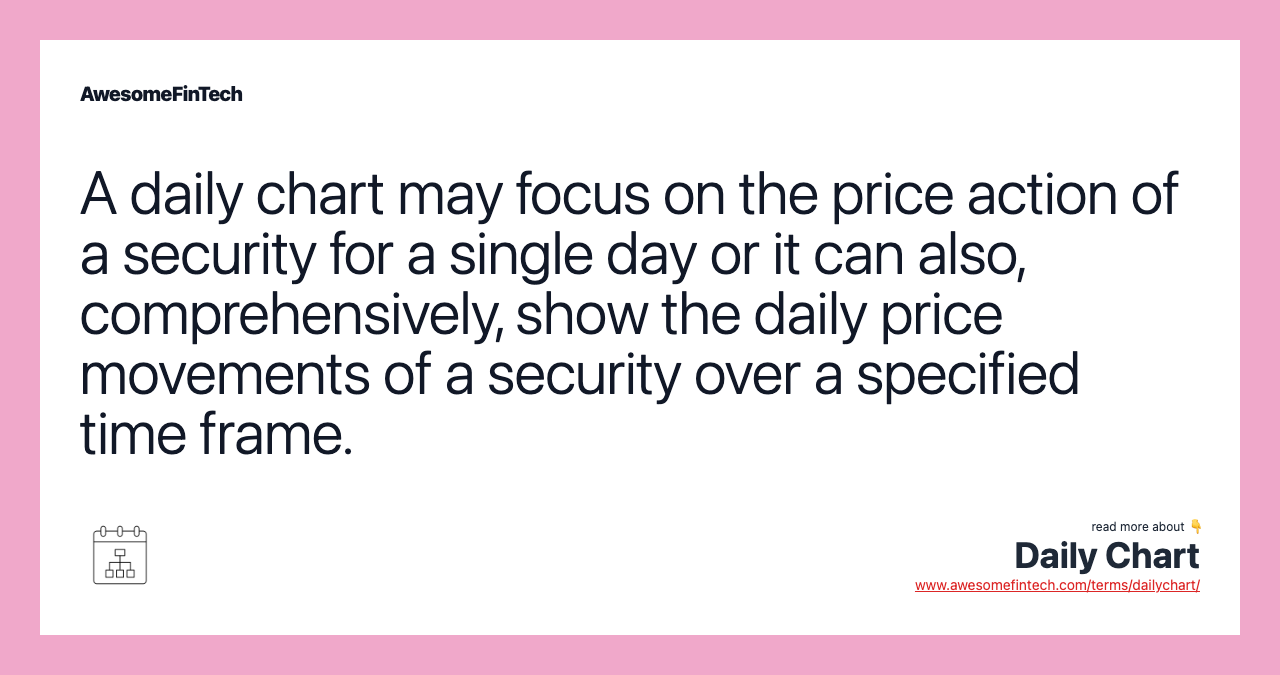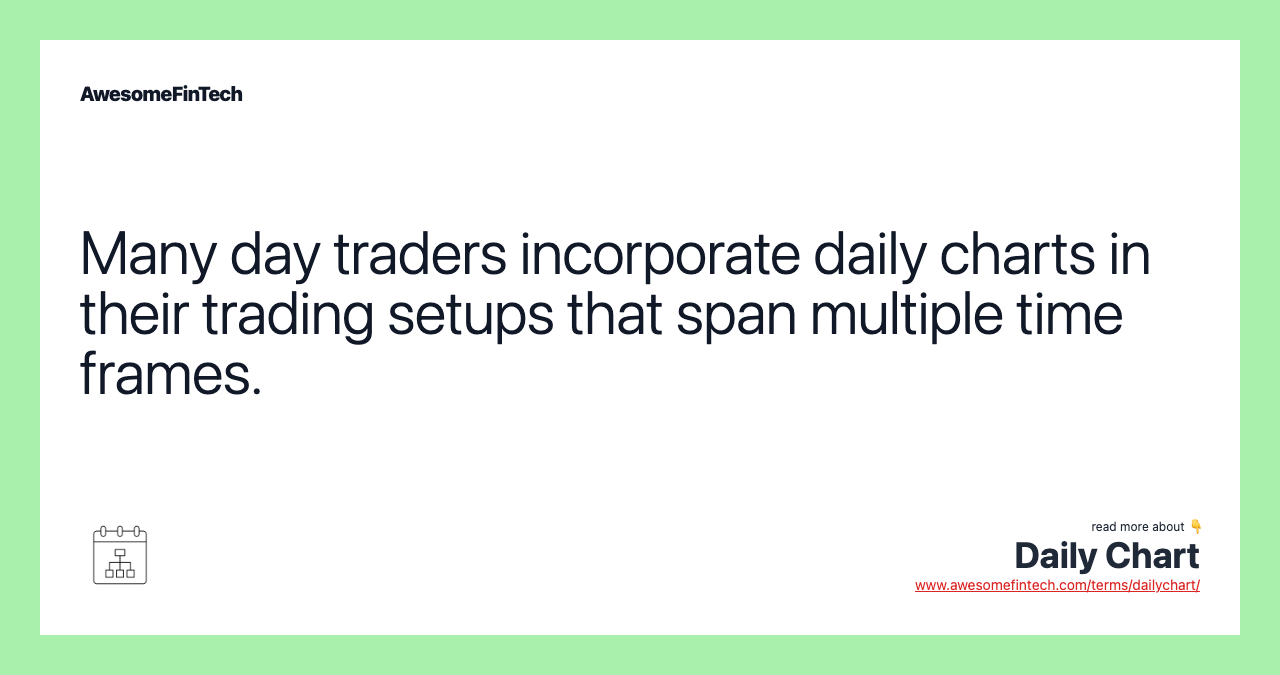Daily Chart
A daily chart is a graph consisting of a security's price action during a single day of trading. A daily chart may focus on the price action of a security for a single day or it can also, comprehensively, show the daily price movements of a security over a specified time frame. A daily chart may focus on the price action of a security for a single day or it can also, comprehensively, show the daily price movements of a security over a specified time frame. More and more, candlestick charts are gaining popularity amongst traders mainly due to the ease with which they convey the basic information, such as the opening and closing price, as well as the trading range for the selected period of time. Candlestick formations, however, will vary based on the time period used in creating the chart. A daily chart is a graph of data points, where each point represents the security's price action for a specific day of trading.

What Is a Daily Chart?
A daily chart is a graph consisting of a security's price action during a single day of trading. Commonly, these data points are depicted by bar, candlestick, or line charts.
A daily chart can be compared with weekly charts.



Understanding Daily Charts
Daily charts are one of the main tools used by technical traders seeking to profit from intraday price movements and longer-term trends. A daily chart may focus on the price action of a security for a single day or it can also, comprehensively, show the daily price movements of a security over a specified time frame.
More and more, candlestick charts are gaining popularity amongst traders mainly due to the ease with which they convey the basic information, such as the opening and closing price, as well as the trading range for the selected period of time.
Candlestick formations, however, will vary based on the time period used in creating the chart. Price charts can be graphed by selecting the time frame for each period. This could range from one minute to one year, though the most commonly used time frames are hour, day, week, and month. Many technical analysts may use an intra-day chart in combination with a longer-term chart for trading analysis.
Intra-day charts graph the movement of a security’s price from the time the market opens to the time it closes. Analysts can specify the candlestick display time frames they wish to view in this type of chart through their trading system’s settings. The candlestick bars will form on the chart in real-time based on the designated settings. Common settings are five or ten minutes per candlestick.
Many traders work with intraday price charts based on data that consist of 1-, 5-, 15-or 60-minute intervals.
Multiple Trading Sessions
Charts with multiple trading sessions will display a series of daily candlestick formations, showing the price movements for a specified period of time. Technical analysis trading research has shown that technical trading is often more successful when following the tides and waves of a security’s price trend rather than intraday ripples. Thus, candlestick charts showing multiple trading sessions are often more commonly used.
Image by Julie Biang © Investopedia 2021
In the above example, each candlestick represents a single day or trading session for the SPDR S&P 500 ETF (SPY). Note that there are about five months worth of trading data contained in the chart, which differentiates it from an intraday chart.
The line between days may be blurred in some markets. For example, the foreign exchange (forex) market operates 24 hours per day, which means that there is technically no stoppage of trading between one trading day and the next. The convention in these cases is to consider a single day to be 5:00 p.m. Eastern Time to 5:00 p.m. Eastern Time the next day. Most websites and applications that provide daily charts are automatically displayed this way.
Uses of Daily Charts
Many day traders incorporate daily charts in their trading setups that span multiple time frames. For instance, day traders may have two monitors displaying trades by the hour and trades over the past several days. This can help a trader to get a more complete picture of a security’s trading action.
Day traders use daily charts as their primary source of information. Typically trading systems will overlay candlestick formations with technical patterns and alerts. Traders can customize their price charts to include channels, as well as a variety of signal alerts to help them identify profitable trading opportunities.
Related terms:
Active Trading
Active trading is the buying and selling of securities or other instruments with the intention of only holding the position for a short period of time. read more
Bar Chart
A bar chart shows where the price of an asset moved over a period of time and is useful for tracking prices and aiding in trading decisions. read more
Channel
A channel may refer to a distribution system for businesses or a trading range between support and resistance on a price chart. read more
Foreign Exchange (Forex)
The foreign exchange (Forex) is the conversion of one currency into another currency. read more
Intraday
In the financial world, the term intraday is shorthand used to describe securities that trade on the markets during regular business hours and their highs and lows throughout the day. Day traders closely watch these moves, hoping to score quick profits. read more
Line Chart
A line chart connects a series of data points with a line and is used by traders to monitor closing prices. read more
Security : How Securities Trading Works
A security is a fungible, negotiable financial instrument that represents some type of financial value, usually in the form of a stock, bond, or option. read more
Swing Trading
Swing trading is an attempt to capture gains in an asset over a few days to several weeks. Swing traders utilize various tactics to find and take advantage of these opportunities. read more
Technical Analysis of Stocks and Trends
Technical analysis of stocks and trends is the study of historical market data, including price and volume, to predict future market behavior. read more
Trendline & Example
A trendline is a charting tool used to illustrate the prevailing direction of price. Trendlines are created by connecting highs or lows to represent support and resistance. read more